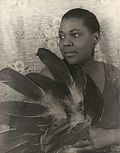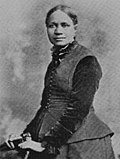List of 999 women of the Heritage Floor / Sojourner Truth
This list describes the place settings for Sojourner Truth on the table of Judy Chicago's art installation The Dinner Party . It is part of the list of 999 women on the Heritage Floor who are assigned to the respective place settings on the table. The names of the 999 women are on the tiles of the Heritage Floor, which is arranged below the table and belongs to the art installation.
description
The installation consists of a three-sided table, each with 13 historical or mythological personalities, thus a total of 39 people, from prehistory to the women's rights movement . These people were assigned a place setting at the table, consisting of an individually designed table runner, an individually designed plate, a goblet, knife, fork, spoon and serviette. The first page of the table is devoted to prehistory up to the Roman Empire , the second to Christianization up to the Reformation and the third from the American Revolution to the women's movement. Each place setting on the table is assigned additional personalities who have received an entry on the tiles of the Heritage Floor, which occupies the space under the table and the center of the space between the sides of the table. This list captures the personalities assigned to the Sojourner Truth table setting. Your seat is on the third side of the table.
Hints
In addition to the names as they are used in German transcription or in scientific usage, the list shows the spelling chosen by Judy Chicago on the tiles.
The information on women who do not yet have an article in the German-language Wikipedia is referenced by the individual references listed under comments . If individual information in the table is not referenced via the main article, additional individual references are given at the relevant point. If there are any discrepancies between the information provided in Wikipedia articles and the descriptions of the work of art on the Brooklyn Museum website , this will also be indicated under Comments.
Place setting for Sojourner Truth
Sojourner Truth was born around 1797 in Hurley , New York, to the enslaved Elisabeth (Ma Ma Bett) and James (Bomefree). At first she was called "Isabella". Asurname was unusualfor a slave , but since her father was called "Bomefree", she was initially called "Isabella Bomefree". Like her family, she belonged to theHardenberghfamily, whohad immigratedfrom the Netherlands . After the death of Johannes Hardenbergh in 1799, it was bequeathed to his son, Carles Hardenbergh. When Carles died, her parents had already been released because of their age, while Isabella, who was around nine years old, was put up for auction. John Neely, a merchant from near Kingston, won the bid for $ 100. Since Isabella was believed to have grown up speaking the Dutch language, she found it difficult to work for the English Neely family and if she did not understand instructions she was punished with the whip. In 1810 she bought John Dumont, an Ulster County farmer who did not beat his slaves.
Isabella fell in love with Robert, a slave from a neighboring farm, around 1815. Its owner forbade the relationship and Robert was separated from her, she never saw him again. Her owner Dumont forced her to marry a slave named Thomas. This relationship resulted in four children, and Isabella also had a son whose biological father was Robert. Dumont had promised her freedom, but he would not let her go. That's why Isabella fled to the Quaker Isaac van Wagenen in 1826. He bought her and her youngest daughter free.
After she was free, Isabella converted to Christianity and moved to New York City with her son as a house maid in 1829. There she joined the Christian utopian Zion's Hill congregation in 1832, whose leader Robert Matthews claimed to be sent by God as a prophet. The community was dissolved in 1834. In 1843, after receiving religious inspiration , Isabella decided to travel the country as an itinerant preacher . She took on the name Sojourner Truth . Through the reformist members of the "Northampton Association of Massachusetts" she came into contact with progressive abolitionist and feminist ideas.
As a woman and former slave, she quickly became known. Their acumen and the intensity of their speeches spread. Her speech “And ain't I a woman ?!” (And am I not a woman?), Which she gave in Ohio in 1851 on the occasion of a women's rights convention, became legendary. By publishing her life story, which her friend Olive Gilbert wrote down (Sojourner Truth could not write) and William Lloyd Garrison's published "The Narrative of Sojourner Truth: A Northern Slave" in 1850, she had made a little money and was able to make a living from it buy your own house. She moved to Washington, DC , where she looked after black soldiers who had returned from the Civil War . She taught housekeeping to provide a livelihood for freed slaves and campaigned against racial segregation on public transport. To accomplish this goal, she even spoke to President Lincoln .
In 1867, Sojourner Truth initiated an African American recruitment agency and worked for the Freedman's Relief Association . In the last years of her life she advocated the right to vote for women and blacks, spoke out against tobacco, alcohol and fashionable clothing, supported independence against excessive dependence on state institutions and advocated the formation of a new colony for freed slaves . She died in Battle Creek , Michigan in 1883 .
The place setting for Sojourner Truth stands out from the other place settings on the dinner table. Your plate was not designed with the usual butterfly bulges, but shows three African-style women's faces in mask form. One is to the left, one is straight and one is directed to the right. These three faces share a female body, which is suggested by the rounded breasts. According to Chicago, the tear on the face on the left indicates the suffering of her fellow slaves. The highly stylized face on the right, in an open-mouthed expression of outrage, represents the wrath of black women in their enslavement, and the raised fist on the right is a powerful gesture reminiscent of Sojourner Truth's speech at the 1851 Women's Rights Convention . The middle face, a mask consisting of black and white triangular patterns, represents the oppression of women, whether black or white, who had to hide their true selves.
The table setting dedicated to Sojourner Truth unites their African heritage with the footprints Sojourner Truth left in American history. The table runner connects quilting's African origins with its history in the United States. Its edges are in the African stripe weaving technique traditionally used by slaves combined with a work technique introduced to the United States by European women. According to Chicago, this combination is said to represent the "fusion of these two traditions in the development of American quilts".
| Surname | Spelling on the tile | Date of birth | cultural spatial assignment | Remarks | image |
|---|---|---|---|---|---|
| Angelina Emily Grimke | Angelina Grimké | 1805 | United States | Christian women's rights activist and abolitionist . Wrote the first tract in the United States on women's rights, letters on gender equality, and the condition of women in 1838. |

|
| Anna Carroll | Anne Ella Carroll | 1815 | United States | Politician, publicist and lobbyist . She played an important role as an advisor to Lincoln during the American Civil War . |

|
| Bessie Smith | Bessie Smith | 1894 | United States | Blues singer , mostly active in the 1920s, made more than 150 records and was considered the " Empress of the Blues ". |

|
| Edmonia Lewis | Edmonia Lewis | probably 1844 | United States | Sculptor. She was the first African American sculptor to achieve fame and recognition in the international art world. |

|
| Frances Harper | Frances Harper | 1825 | United States | African American abolitionist, poet, and author. She was also active in other types of social reform and was a member of the Woman's Christian Temperance Union . |

|
| Harriet Beecher Stowe | Harriet Beecher Stowe | 1811 | United States | Writer and declared opponent of slavery . Her best-known work is the book Onkel Toms Hütte from 1852. |

|
| Harriet Tubman | Harriet Tubman | 1820 | United States | Afro-American escape worker for the Underground Railroad aid organization . |

|
| Ida B. Wells | Ida B. Wells | 1862 | United States | Journalist and civil and women's rights activist . She co-founded numerous organizations, including the NAACP and the NACW (National Association of Colored Women), and campaigned prominently against the then widespread lynching of African Americans . |

|
| Josephine Baker | Josephine Baker | 1906 | United States , France | Dancer , singer and actress . Born in America, she took French citizenship in 1937 , worked for the Resistance and the secret service during World War II and was accepted into the Legion of Honor after the war . |

|
| Lily Ann Granderson | Milla Granson | 1816 | United States | Pioneering educator. | |
| Margaret Murray Washington | Margaret Murray Washington | 1865 | United States | Director of the Tuskegee Normal and Industrial Institute , which later became Tuskegee University . She was the third wife of Booker T. Washington . |

|
| Maria Stewart | Maria Stewart | 1803 | United States | Teacher, journalist, lecturer, abolitionist and suffragette, first African American woman to give public lectures, talk about women's rights and give a public anti-slavery speech. | |
| Marian Anderson | Marian Anderson | 1897 | United States | Opera singer with alt voice , member of the American Academy of Arts and Sciences , recipient of the Presidential Medal of Freedom . |

|
| Mary Ann Shadd Cary | Mary Ann Shadd Cary | 1823 | United States , Canada | Slavery opponent, journalist, publisher, teacher, abolitionist and attorney, first black publisher in North America and first publisher in Canada. |

|
| Mary Livermore | Mary Livermore | 1820 | United States | Journalist, abolitionist and advocate of women's rights. |

|
| Mary McLeod Bethune | Mary McLeod Bethune | 1875 | United States | Women's and civil rights activist , educator, founded a private school for African American students in Daytona Beach, Florida. |

|
| Prudence Crandall | Prudence Crandall | 1803 | United States | Teacher and anti- racial activist in education. She founded the first school for African American students in New England . |

|
| Sarah Moore Grimké | Sarah Grimke | 1792 | United States | American abolitionist , writer, and activist for women's suffrage . |

|
| Zora Neale Hurston | Zora Neale Hurston | 1891 | United States | Writer and folklorist . It is counted as part of the Harlem Renaissance . |

|
- Individual evidence
- ↑ Brooklyn Museum: Sojourner Truth. In: brooklynmuseum.org. Retrieved November 1, 2019 .
- ^ Brooklyn Museum: Margaret Murray Washington. In: brooklynmuseum.org. Retrieved November 1, 2019 .
- ^ Brooklyn Museum: Maria Stewart. In: brooklynmuseum.org. Retrieved November 1, 2019 .
- ↑ Brooklyn Museum: Mary Livermore. In: brooklynmuseum.org. Retrieved November 1, 2019 .
Web links
- Brooklyn Museum, Sojourner Truth
- The Dinner Party on the website of Through the Flower , Judy Chicago's non-profit organization
